Healthcare executives face a strategic dilemma that has paralyzed decision-making for years: choosing between operational simplicity and specialized expertise. This false dichotomy has created the consolidation paradox, the belief that streamlining vendor relationships necessarily means sacrificing best-in-class capabilities.
The resistance is understandable. CFOs have witnessed too many "consolidated" solutions that promise everything but deliver mediocrity. They've seen organizations trade specialized excellence for vendor convenience, only to discover that simplified vendor management came at the cost of performance degradation. With healthcare operating margins typically ranging from negative to low single digits—with about 39% of hospitals operating at negative margins⁹—there's no room for capability compromise⁷.
This fear has created a dangerous mythology: that specialization inherently requires fragmentation. Healthcare leaders convince themselves that assembling multiple point solutions, each supposedly "best-in-class" within their narrow domain, will create an optimal system. The mathematical reality tells a different story.
Consider the specialization myth in practice. Each specialized vendor optimizes their narrow slice, while the handoffs between them, where the real operational costs hide, become entirely your responsibility to manage. Your "specialized" prior authorization solution might excel at routine approvals but fails when exceptions require cross-functional coordination with your billing and collections teams.
The market data reinforces this challenge. The U.S. Revenue Cycle Management Market was valued at $141.61 billion in 2024 and is expected to reach $272.78 billion by 2030, rising at a CAGR of 11.55%¹. Healthcare organizations continue to struggle with fragmented approaches that multiply rather than solve their operational challenges.
Beyond Simple Consolidation:
The Curated Ecosystem Model
True consolidation doesn't eliminate specialization; it orchestrates it. The fundamental difference lies in architectural philosophy: fragmented specialization creates silos that your organization must integrate, while orchestrated specialization creates integrated capabilities that work seamlessly together under unified accountability.
The UnBPO™ model represents this evolution from fragmented to orchestrated specialization. Rather than forcing you to choose between vendor simplicity and functional excellence, it delivers specialized expertise within an integrated operational framework. Think of it as the difference between a jazz ensemble, where each musician plays independently, versus a symphony orchestra, where specialized instruments create harmony under unified direction.
In a curated ecosystem model, specialization serves integration rather than fighting it. Coding specialists work within revenue cycle workflows that seamlessly connect to denial management experts, who coordinate directly with patient financial counseling teams—all operating under a single technology architecture and accountability structure. The specialization exists and thrives, but the integration burden shifts from your organization to your partner.
While point solutions have dominated the RCM technology landscape, 2025 will see a shift toward comprehensive revenue intelligence platforms that provide visibility and optimization across the entire revenue cycle. This architectural approach creates what traditional consolidation cannot: genuine best-of-both-worlds capability. You gain operational simplicity through single-vendor accountability while maintaining—and often exceeding—the performance levels that specialized point solutions promise but rarely deliver due to integration challenges.
The key insight is that specialization without integration is actually a form of operational failure. When your coding vendor's excellent work creates data formatting issues for your denial management system, the specialization becomes counterproductive. When your prior authorization specialist can't communicate effectively with your financial counseling team, the expertise creates rather than solves operational problems.
Human + AI: The Force Multiplier
The human-AI collaboration model represents a fundamental shift in how intelligent automation should work within healthcare revenue cycle management. Rather than replacing human judgment with algorithmic decision-making, the most effective approach creates symbiotic relationships where AI handles scale and routine processing while humans focus on judgment, exception handling, and strategic optimization.
Healthcare revenue cycle management involves significant variability, edge cases, and regulatory complexity that make pure automation challenging to implement effectively. Simultaneously, the volume and routine nature of much RCM work make pure manual processing economically unsustainable and operationally inefficient.
The "human-in-the-loop" approach beats both extremes by creating intelligent workload distribution. AI systems excel at pattern recognition, data processing, and routine decision-making that follows established rules. They can process thousands of claims, identify likely denial patterns, and flag potential issues faster and more consistently than human teams. However, when exceptions arise—and they always do in healthcare—human expertise becomes irreplaceable.
Consider prior authorization management as a specific example. AI can instantly analyze clinical documentation against payer requirements, identify missing elements, and route straightforward approvals through automated workflows. For instance, as demonstrated in a national physical therapy provider case study⁸, AI-driven automation can handle routine cases while human expertise manages complex exceptions.
This collaborative model creates operational leverage that neither pure automation nor pure manual processing can achieve. The key is architectural integration—the AI and human capabilities must work within unified workflows rather than operating as separate systems that require coordination.
The force multiplier effect becomes most apparent in exception handling, where complex cases typically drive the majority of operational complexity. AI systems can instantly identify these exceptions and route them to appropriate human expertise with complete contextual information, while simultaneously learning from human decisions to improve future automated processing. This creates a virtuous cycle where system intelligence improves over time while human experts focus on the high-value, high-complexity work that drives revenue optimization.
The Vendor Selection Framework:
Evaluating True Consolidation
Healthcare organizations need a systematic approach to distinguish genuine orchestrated consolidation from sophisticated bundling. The difference determines whether consolidation delivers a strategic advantage or simply reorganizes existing operational problems under a single vendor relationship.
Current market dynamics make this distinction critical. According to Kodiak Solutions data from more than 2,100 hospitals and 300,000 physicians, the initial denial rate on claims in 2024 increased 2.4% to 11.81%². This reflects ongoing coordination challenges in fragmented RCM environments.
Key Questions to Distinguish Genuine Orchestrated Consolidation
Technology Integration Depth
Ask prospective vendors to demonstrate live workflow handoffs between different functional areas. Genuine consolidation shows seamless data flow from patient registration through final payment without manual intervention or data re-entry. Bundled solutions will reveal disconnected systems requiring manual coordination, even under single vendor management.
Request specific examples of how the platform handles exceptions that span multiple functional areas. A prior authorization denial that affects billing timelines and requires patient financial counseling should trigger coordinated workflows across all three areas automatically. Fragmented bundling will show point solutions that still require your team to coordinate the cross-functional response.
Accountability Structure Verification
Examine the vendor's performance guarantees and accountability metrics. True consolidation includes end-to-end accountability with financial penalties for overall revenue cycle performance, not just individual functional metrics. If the vendor only guarantees coding accuracy but takes no responsibility for overall claim payment rates, you're looking at bundled point solutions rather than integrated accountability.
According to the American Hospital Association, 62% of prior authorization denials and 50% of initial claims denials that were appealed were overturned³, indicating massive inefficiency in current coordination models. Investigate escalation and problem resolution processes. When performance issues arise, genuine consolidation provides single-point resolution with clear authority to coordinate across all functional areas.
Assessment Criteria: Depth of Specialization Within Unified Delivery
Functional Expertise Validation
Evaluate whether the vendor maintains specialized expertise within their integrated model or has simply hired generalists to cover multiple areas. For instance, our work with a leading healthcare provider demonstrates how organizations can increase physician reimbursements significantly by leveraging deep specialization within an integrated delivery model. Request specific examples of complex case handling in each functional area, along with credentials and experience levels of the teams handling specialized work.
Examine the vendor's approach to regulatory changes and payer updates. Specialized expertise within integration means dedicated teams monitoring specific areas while coordinating implementation across the entire revenue cycle. Bundled generalization means delayed responses as teams try to understand changes across too many functional areas.
Technology Architecture Assessment
Request detailed technical architecture documentation showing how different functional areas share data and coordinate workflows. Genuine consolidation shows purpose-built integration with real-time data sharing and automated workflow triggers. Bundled solutions reveal point solutions connected through APIs or manual processes.
Evaluate the vendor's AI and automation capabilities across the entire revenue cycle. True consolidation uses machine learning models that optimize across functional boundaries, learning from coding decisions to improve denial prevention and from denial patterns to enhance patient financial counseling approaches.
Red Flags vs. Green Flags in Vendor Evaluation
Red Flags: Signs of Sophisticated Bundling
- Vendor cannot demonstrate live, real-time workflow integration between functional areas
- Performance guarantees are limited to individual functional metrics rather than overall revenue cycle outcomes
- Different teams handle different functions with limited cross-functional communication protocols
- Technology architecture relies heavily on APIs to connect separate point solutions
- Vendor acquired multiple specialized companies recently, but hasn't integrated operations
- Exception handling still requires client coordination between different vendor teams
- Implementation requires separate onboarding for different functional areas
Green Flags: Indicators of Genuine Orchestrated Consolidation
- Seamless demonstration of cross-functional workflow automation with real-time data sharing
- End-to-end accountability with financial guarantees for overall revenue cycle performance
- Integrated exception handling where complex cases automatically trigger coordinated response across relevant teams
- Purpose-built technology architecture designed for revenue cycle integration rather than assembled point solutions
- AI and automation capabilities that optimize across functional boundaries
- Single implementation process covering all functional areas with unified training and support
- Proven track record of delivering consolidated results rather than just consolidated contracts
Due Diligence Framework: Validating Integration and Expertise
Reference Client Deep Dive
Conduct detailed reference calls focusing specifically on integration effectiveness rather than individual functional performance. Ask reference clients about exception handling, cross-functional coordination, and vendor responsiveness when issues span multiple areas.
The best way for a practice to assess potential vendors is to create a comprehensive list of requirements through a request for proposal (RFP) process. Request access to reference client performance dashboards to verify that consolidated metrics show improvement over previous fragmented approaches. Look specifically for metrics around denial prevention, payment acceleration, and overall cost reduction rather than just individual functional improvements.
Operational Assessment Protocol
Require prospective vendors to analyze a sample of your most complex cases spanning multiple functional areas. Evaluate their proposed handling approaches for evidence of true integration versus bundled coordination. Healthcare Financial Management Association experts recommend focusing on two main key metrics when evaluating an RCM service:
- Costs to collect (the percentage of revenue needed to collect payments); and
- ROI—return on that investment⁵.
Examine the vendor's organizational structure and reporting relationships. Genuine consolidation shows integrated management structures where functional leaders coordinate directly rather than operating as independent business units under a corporate umbrella.
ROI Modeling: Calculating True Consolidation Value
Fragmentation Cost Baseline
Calculate your current vendor management overhead, including IT integration costs, coordination time, and exception handling burden. Include the opportunity cost of leadership time spent on vendor coordination rather than strategic initiatives.
Measure current performance gaps between vendors, including handoff delays, data inconsistencies, and accountability gaps when issues span multiple vendor relationships. Quantify the revenue impact of these integration failures.
Consolidated Value Projection
Model the elimination of vendor management overhead and integration complexity. Calculate the value of redirecting internal resources from vendor coordination to strategic initiatives and operational optimization.
Project revenue improvement through integrated exception handling, faster resolution of complex cases, and elimination of handoff delays that impact payment timing. Include the strategic value of unified performance visibility and coordinated optimization across the entire revenue cycle.
Risk Assessment Framework
Evaluate the implementation risk of consolidated transition compared to continued fragmentation management. Include the ongoing risk of vendor coordination failures and the escalating complexity as regulatory requirements increase.
According to the American Medical Association, 94% of physicians reported that prior authorization led to delays in patients' access to necessary care, and 78% of physicians reported that the process can at least sometimes lead to patients abandoning their physicians' recommended course of treatment⁴. Assess the competitive advantage potential of consolidated operations versus continued operational overhead from fragmented vendor relationships. Consider the strategic flexibility gained through single-partner accountability versus the operational rigidity of managing multiple specialized relationships.
Conclusion
Healthcare organizations that master this vendor selection framework position themselves to achieve genuine consolidation advantages, operational simplicity without capability compromise, specialized expertise within integrated accountability, and strategic focus instead of vendor management overhead. Organizations that continue operating under the consolidation paradox will find themselves increasingly disadvantaged as operational complexity intensifies and margin pressure eliminates tolerance for inefficient vendor relationships.
The choice is clear: continue absorbing the hidden costs of vendor coordination while competitors streamline their operations, or partner with a vendor that delivers true orchestrated consolidation. The question isn't whether consolidation is right for your organization; it's whether you can afford to delay the decision while others gain sustainable competitive advantages.
For more information about how Firstsource can help your organization transform complex vendor relationships into a single, accountable partnership that drives measurable results, contact Nirmal Kumar Rajachandran - Head Provider RCM Business at Firstsource or Ashok Menon, Sr. Vice President – Sales and Client Relations.
Sources
¹ ResearchAndMarkets.com, "U.S. Revenue Cycle Management Market - Focused Insights 2025-2030," January 29, 2025
² Kodiak Solutions (via Becker's Payer Issues), "Claims denial rates up, prior auth denials down in 2024: Report," May 23, 2025
³ American Hospital Association, "Payer Denial Tactics — How to Confront a $20 Billion Problem," April 2, 2024
⁴ American Medical Association, "Prior authorization denials up big in Medicare Advantage," September 23, 2024
⁵ Healthcare Financial Management Association (via Medical Economics), "10 tips to assess Revenue Cycle Management vendors," November 12, 2020
⁶ Medical Billers and Coders, "Criteria to Assess Healthcare Revenue Cycle Management Vendors," March 29, 2021
⁷ KFF, "Hospital Margins Rebounded in 2023, But Rural Hospitals and Those With High Medicaid Shares Were Struggling More Than Others," December 18, 2024
⁸ Firstsource Case Study, "National Physical Therapy - Eligibility Verification Success," https://www.firstsource.com/insights/case-studies/national-physical-therapy-eligibility-verification-success
⁹ Firstsource Case Study, "Healthcare Provider Services Company Increases Reimbursements - Physician," https://www.firstsource.com/insights/case-studies/healthcare-provider-services-company-increases-reimbursements-physician










